43rd Oi Match Game 1
Black: Habu Yoshiharu, Oi
White: Tanigawa Koji, Challenger
43rd Oi-sen, Game 1, July 12th and 13th 2002
1.P2g-2f 00:01:00 00:00:00
2.P3c-3d 00:01:00 00:08:00
3.P7g-7f 00:02:00 00:08:00
4.P5c-5d 00:02:00 00:13:00
The Kondo-style Gokigen Nakabisha is going through a remarkable revival
recently. Five years ago, Kondo Masakazu (5-dan) had great success with
it, reaching the quarterfinals of the Ryu-O challenger tournament where
it took the likes of Sato Yasumitsu to stop his run. However, after that
it seemed like his opponents adapted to this quick attacking system and
Kondo's results became less impressive. Five years later, he is still
struggling in C2 and has had only anonymous performances in the other
tournaments. Still, he stubbornly stuck to his own system (I have never
seen him play anything else), which I thought was a waste. Being a
predictable, one-dimensional player is definitely a problem in modern
professional shogi where opening preparation has become almost as
important as in chess. However, last year everything suddenly changed
for Kondo. Other professionals started to take a closer look at his
system and it now seems more popular even than the Chuza Yokofudori
(I have no data to back this up yet). It is not surprising that players
like Suzuki and Kubo play this system as they play every ranging
rook game with attack in mind. However, the Kondo-style Gokigen
Nakabisha has also been played by Meijin Moriuchi and Sato Yasumitsu.
Tanigawa joins the crowd in this game and this must have taken Habu
completely by surprise as he took 51 minutes for his next move.
5.P2f-2e 00:53:00 00:13:00
6.R8b-5b 00:53:00 00:15:00
7.G4i-5h 00:56:00 00:15:00
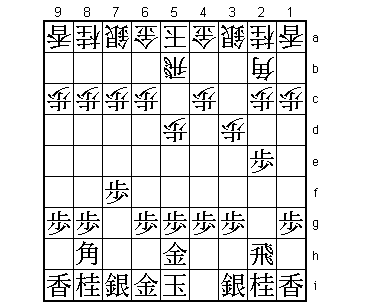
The main line these days is 7.G7h. The difference will become clear
very soon. We are only 7 moves into the game, but with this extremely
sharp move Habu makes clear that he will not back out of an early fight.
8.P5d-5e 00:56:00 01:27:00
After the game Tanigawa admitted that he put most of his homework in
the position after G7h.
9.P2e-2d 02:18:00 01:27:00
10.P2cx2d 02:18:00 03:06:00
11.R2hx2d 02:18:00 03:06:00
12.P5e-5f 02:18:00 03:06:00
13.P5gx5f 02:38:00 03:06:00
14.B2bx8h+ 02:38:00 03:16:00
15.S7ix8h 02:39:00 03:16:00
16.B*3c 02:39:00 03:16:00
The difference between 7.G4i-5h and 7.G7h. With the gold on 7h, this
would not be a fork on rook and silver. It is difficult to say if G7h
is really better than G4i-5h as there are so many sharp variations.
However, from this game it seems that black is the side that has to
fight to stay in the game, which is not a good sign.
17.R2dx2a+ 02:58:00 03:16:00
18.B3cx8h+ 02:58:00 03:16:00
19.N*5e 02:58:00 03:16:00
20.K5a-6b 02:58:00 03:22:00
21.+R2ax1a 02:58:00 03:22:00
22.+B8hx9i 02:58:00 03:43:00
23.L*6f 04:03:00 03:43:00
The sealed move. It must be very rare that a whole day of play ends
with only 23 moves being played.
24.S*5d 04:03:00 03:48:00
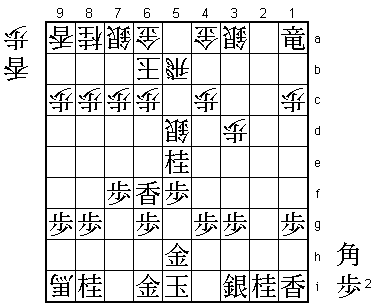
25.B*2c? 04:24:00 03:48:00
Better seems 25.P*2b. After 26.L*5c! (a move found by Suzuki Daisuke)
B*3f S7b P2a+ Sx5e Px5e Lx5e +Px3a Lx5h+ Gx5h P*5g P*5d Px5h+ Kx5h
N*7d white has the advantage, but Habu was not convinced that this
was conclusive variation and said after the game that he should have
tried 25.P*2b instead of 25.B*2c.
26.G6a-5a 04:24:00 05:09:00
27.B2cx3d+ 04:40:00 05:09:00
28.S3a-4b 04:40:00 05:10:00
29.P*2c 05:35:00 05:10:00
30.K6b-7b 05:35:00 05:50:00
31.P2c-2b+ 05:36:00 05:50:00
32.L*6a! 05:36:00 05:52:00
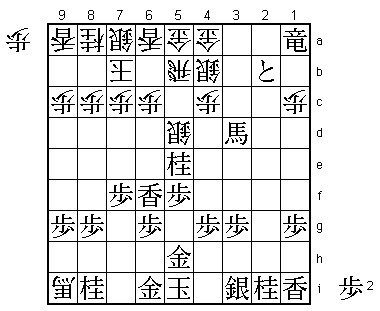
As Tsukada (9-dan) pointed out, 30.K7b is a move that most professionals
would have played. Moving the king away from danger followed by defending
the pawn on 6c with S6b next is a natural way to strengthen the position
and this position was analysed at length in the press room. To
everyone's surprise, Tanigawa played 32.L*6a. This move not only
defends 6c, but also aims at the counterattack P6d-P6e. However,
dropping this lance in defence takes a lot of courage. The counterattack
along the 6th file takes quite a lot of moves and it is far from clear
that the white attack will be in time. Tanigawa has all judged it
perfectly.
33.P*2d 06:11:00 05:52:00
34.P6c-6d 06:11:00 05:57:00
35.P2d-2c+ 06:16:00 05:57:00
After the game, Habu regretted his confidence in the attack with the
two promoted pawns. It looks strong, but it turns out that it is
difficult to get two tokins moving towards the white king.
36.P*3a 06:16:00 06:12:00
37.+P2c-3c 07:15:00 06:12:00
38.P6d-6e 07:15:00 06:12:00
39.+P2bx3a? 07:16:00 06:12:00
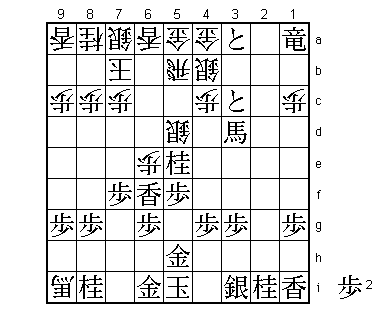
Better was 39.Lx6e but after 40.Lx6e +Px4c S5dx4c Nx4c+ Sx4c +Bx4c
L*6a S*5c P*5g Gx5g Lx6g+ Gx6g Lx6g+ it looks like black's attack
isn't strong enough. The promoted bishop on 9i is very powerful and
the black promoted rook on 1a isn't working at all.
40.S4bx3a 07:16:00 06:17:00
41.+P3cx4c 07:17:00 06:17:00
42.R5b-6b 07:17:00 06:17:00
43.+P4c-5c 07:21:00 06:17:00
44.R6b-3b 07:21:00 06:19:00
45.+B3d-4d 07:27:00 06:19:00
46.S5dx5e 07:27:00 06:19:00
47.+B4dx5e 07:27:00 06:19:00
48.P6ex6f 07:27:00 06:19:00
49.P6gx6f 07:30:00 06:19:00
50.K7b-8b 07:30:00 06:19:00
This move made Habu lose his will to fight. The white king is too far
to set up a decent attack. Tsukada still thought things were far from
easy though...
51.+R1a-2a? 07:32:00 06:19:00
According to Tsukada, a better fighting chance was 51.+Rx1c +Bx6f +Bx6f
Lx6f P*6g P*5g (Gx5g is then answered by B*3e). White is clearly better
but the game is not over as quickly.
52.P*5b 07:32:00 06:42:00
53.+P5c-5d 07:33:00 06:42:00
54.R3b-2b! 07:33:00 06:42:00

Great finish. It is not unlikely that this move took Habu by surprise.
55.+B5ex2b 07:43:00 06:42:00
56.S3ax2b 07:43:00 06:42:00
57.S*3b 07:43:00 06:42:00
Defends against G*3a. Black can't take the silver as 57.+Rx2b fails
to 58.+Bx6f.
58.+B9ix6f 07:43:00 06:47:00
59.P*6b 07:45:00 06:47:00
60.+B6fx3i 07:45:00 06:54:00
61.P6bx6a+ 07:45:00 06:54:00
62.S*5g 07:45:00 06:55:00
63.G5hx5g 07:45:00 06:55:00
64.+B3ix5g 07:45:00 06:56:00
65.S*4h 07:51:00 06:56:00
66.+B5g-6g 07:51:00 07:02:00
67.G6i-6h 07:51:00 07:02:00
Or 67.G5h N*6f and white wins.
68.G*4i 07:51:00 07:03:00
Resigns 07:51:00 07:03:00
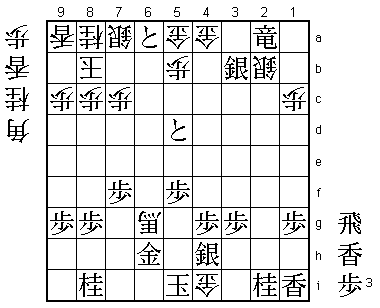
Not mate, but black is left without defence after 69.K6i L*6f Gx6g Lx6g+.
A very important win for Tanigawa for a number of reasons. First of all,
winning with white against an opponent he has great problems with is a
great start in an attempt to end a title drought of more than a year.
Furthermore, this was Tanigawa's 1000th victory as a professional. He
is only the 7th player in history to reach this milestone. At 40 years
and 3 months he is the youngest player to get 1000 wins (beating
Nakahara's previous record of 44 years and 4 months) and he is also
the player who took the shortest time from his professional debut with
25 years and 6 months (just beating Nakahara with 26 years and 3 months).
After the game Tanigawa was a relieved man, as he lost two games in a
row at 999 wins, making life for the anticipating crowd of journalist
quite difficult. Of course all the records will be broken by Habu in a
couple of years (Habu has now 759 wins), but with having this extra
pressure out of the way, Tanigawa can play a little more freely to try
and take the Oi title from his nemesis.





